Articles
- Page Path
- HOME > Korean J Community Nutr > Volume 24(4); 2019 > Article
-
Research Article
- Comparison Analysis of Dietary Behavior and Nutrient Intakes of the Elderly according to Their Family Status: The Korea National Health and Nutrition Examination Survey 2013–2016
-
Ji-Hong Oh
 , Bok-Mi Jung
, Bok-Mi Jung
-
Korean Journal of Community Nutrition 2019;24(4):309-320.
DOI: https://doi.org/10.5720/kjcn.2019.24.4.309
Published online: August 31, 2019
1Major in Nutrition Education, Graduate School of Education, Chonnam National University, Gwangju 61186, Korea, Student.
2Division of Food and Nutrition, Chonnam National University, Research Institute for Human Ecology, Gwangju 61186, Korea, Professor.
- Corresponding author: Bok-Mi Jung. Division of Food and Nutrition, Chonnam National University, Gwangju 61186, Korea. Tel: (062) 530-1353, Fax: (062) 530-1339, jbm@jnu.ac.kr
Copyright © 2019 The Korean Society of Community Nutrition
This is an Open-Access article distributed under the terms of the Creative Commons Attribution Non-Commercial License (http://creativecommons.org/licenses/by-nc/3.0/) which permits unrestricted non-commercial use, distribution, and reproduction in any medium, provided the original work is properly cited.
- 200 Views
- 4 Download
- 8 Crossref
Abstract
-
Objectives
- This study was undertaken to compare dietary life of the elderly living alone and in a family, and to compare differences based on gender, for the 2013-2016 Korea National Health and Nutrition Examination Survey (KNHANES).
-
Methods
- The subjects included 2,612 elderly people aged over 65 years who participated in the health survey, health examination and nutrition survey. Subjects on a diet therapy were excluded. This study analyzed the general characteristics, dietary habits, daily energy and nutrient intakes, CPF ratio, estimated average requirement (EAR), nutrient adequacy ratio (NAR) and mean adequacy ratio (MAR), index of nutrient quality (INQ), and food consumption of the elderly living alone and in a family. We also compared the differences based on gender.
-
Results
- Daily intake of food, water, dietary fiber, potassium, retinol, and riboflavin were low in the male elderly subjects living alone. The elderly living with family revealed higher NAR and MAR as compared to the elderly living alone. Although all MAR values were <1, the elderly living alone had lower values. Considering the intake of food, the consumption of seaweed, fish and shellfish, and oils (animal) was higher in elderly men living with families, whereas women living with families consumed more vegetables, fruits, seaweeds and seafood, as compared to their counterparts living alone. Furthermore, analyzing the foods consumed by the elderly people living alone, female subjects consumed more seaweed, milk and animal oil as compared to male subjects.
-
Conclusions
- The results of this study indicate that the elderly living alone have poor nutrient intake as compared to the elderly living with families. Based on this research data, we recommend that it is necessary to improve the health and nutritional status of the elderly living alone.
- 1. Kim HG, Park MH, Kang YS, Jung HK, Jang GS, Lee HS. The elderly circumstances of dietary life, physical activity and mental health by economic activity state. J Korean Acad Health Welf Elder 2012; 4(2): 23-35.
- 2. Kim MY. Nutrient intake and food consumption of Korean elderly aged more than 65 years according to health-related quality of life: the fourth Korea national health and nutrition examination survey (KNHANES IV) 2007–2009 [dissertation]. Graduate School of Chung-Ang University; 2014.
- 3. Statistics Korea. Population census [internet]. Statistics Korea; 2015; cited 2015 Apr 20]. Available from: http://kostat.go.kr/.
- 4. Lim YJ, Choi YS. Dietary behaviors and seasonal diversity of food intakes of elderly women living alone as compared to those living with family in Gyeongbuk rural area. Korean J Community Nutr 2008; 13(5): 620-629.
- 5. Kim YH, Jang MR. A research on analysis of eating habits and textbook contents for efficient nutrition education of elementary school students in Gangneung city. J Korean Diet Assoc 2007; 13(4): 379-388.
- 6. Payette H, Shatenstein B. Determinants of healthy eating in community-dwelling elderly people. Can J Public Health 2005; 96 Suppl 3: S27-S31.PubMed
- 7. Keller HH, Østbye T, Bright-See E. Predictors of dietary intake in Ontario seniors. Can J Public Health 1997; 88(5): 305-309.ArticlePubMedPMCPDF
- 8. Murphy SP, Davis MA, Neuhaus JM, Lein D. Factors influencing the dietary adequacy and energy intake of older Americans. J Nutr Educ 1990; 22(6): 284-291.Article
- 9. Kim YS. The study of the impact of the family type on the health promoting behavior and physical and mental health of elderly people. Health Soc Welf Rev 2014; 34(3): 400-429.Article
- 10. Shin SK, Kim HJ, Choi BY, Lee SS. Comparison of food frequency for the elderly regarding different family types, based on community health survey for 2008. Korean J Nutr 2012; 45(3): 264-273.Article
- 11. Locher JL, Robinson CO, Roth DL, Ritchie CS, Burgio KL. The effect of the presence of others on caloric intake in homebound older adults. J Gerontol A Biol Sci Med Sci 2005; 60(11): 1475-1478.ArticlePubMed
- 12. Jung KH. A study on the living conditions and policy issues of single elderly households. Korea Institute for Health and Social Affairs; 2014 12. Report No. 2014-22-8.
- 13. Han KS, Yand EJ. Evaluation of dietary habit and nutritional intake of Korean elderly: Data from Korea National Health and Nutrition Examination Survey 2013~2015. J East Asian Soc Diet Life 2018; 28(4): 258-271.Article
- 14. Lee JH, Kim SH. Establishment of reference intake of water for Korean adults in 2015. J Nutr Health 2017; 50(2): 121-132.ArticlePDF
- 15. Kim HY, Lee JS, Youn JC, Chang MJ. Food and nutrient intake status of Korean elderly by degree of cognitive function. J Nutr Health 2016; 49(5): 313-322.ArticlePDF
- 16. Kim EM, Choi MK. An analysis of food consumption patterns of the elderly from the Korea national health and nutrition examination survey (KNHANES V-1). J Korean Soc Food Sci Nutr 2013; 42(5): 818-827.
- 17. Park JE, An HJ, Jung SU, Lee YN, Kim CI, Jang YA. Characteristics of the dietary intake of Korean elderly by chewing ability using data from the Korea national health and nutrition examination survey 2007-2010. J Nutr Health 2013; 46(3): 285-295.Article
- 18. Kim C, Park YS. Comparing health-related behaviors, food behaviors, and the nutrient adequacy ratio of rural elderly by single-elderly families vs. extended families. Korean J Community Nutr 2000; 5: Suppl. 307-315.
- 19. Kang NE, Cho MS. A study on nutritional status and its related factors in elderly Koreans with ages. Korean J Food Nutr 1994; 7(4): 361-372.
- 20. Kang Y, Kim MY, Lee E. The relationship of perceived health status, activities of daily living and nutrition status in the community-dwelling Korea elderly. Korean J Acad Nurs 2008; 38(1): 122-130.
- 21. Kim J, Lee Y, Back JH. The association between frequency of food group consumption and functional disability in older people. J Korean Geriatr Soc 2010; 14(1): 25-35.Article
- 22. Thompson JL, Bentley G, Davis M, Coulson J, Stathi A, Fox KR. Food shopping habits, physical activity and health-related indicators among adults aged ≥70 years. Public Health Nutr 2011; 14(9): 1640-1649.ArticlePubMed
- 23. Kim HS, Jung GH, Jung DM, Kim SH, Lee BK. Increased calcium intake milk consumption and bone mineral density of elderly women living in Asan. J Korean Diet Assoc 2005; 11(2): 242-250.
- 24. Rurik I. Nutritional differences between elderly men and women. Ann Nutr Metab 2006; 50(1): 45-50.ArticlePubMedPDF
- 25. Lee YJ, Kwon MK, Baek HJ, Lee SS. Comparative analysis of food intake according to the family type of elderly women in Seoul area. J Nutr Health 2015; 48(3): 277-288.Article
- 26. Park MS, Suh YS, Chung YJ. Comparison of chronic disease risk by dietary carbohydrate energy ratio in Korean elderly: Using the 2007-2009 Korea national health and nutrition examination survey. J Nutr Health 2014; 47(4): 247-257.Article
- 27. Kim SW, Kim KI. Metabolic change and nutritional supply in the elderly. Korea J Clin Nutr 2014; 6(1): 2-6.Article
- 28. Lee YN, Lee HJ, Lee HS, Jang YA, Kim CI. Nutritional status and revision of the elderly living alone. Korean J Community Nutr 2006; 11(3): 401-411.
- 29. Posner BM, Jette AM, Smith KW, Miller DR. Nutrition and health risks in the elderly: the nutrition screening initiative. Am J Public Health 1993; 83(7): 972-978.ArticlePubMedPMC
REFERENCES
General characteristics of the elderly living alone and the elderly living with their families
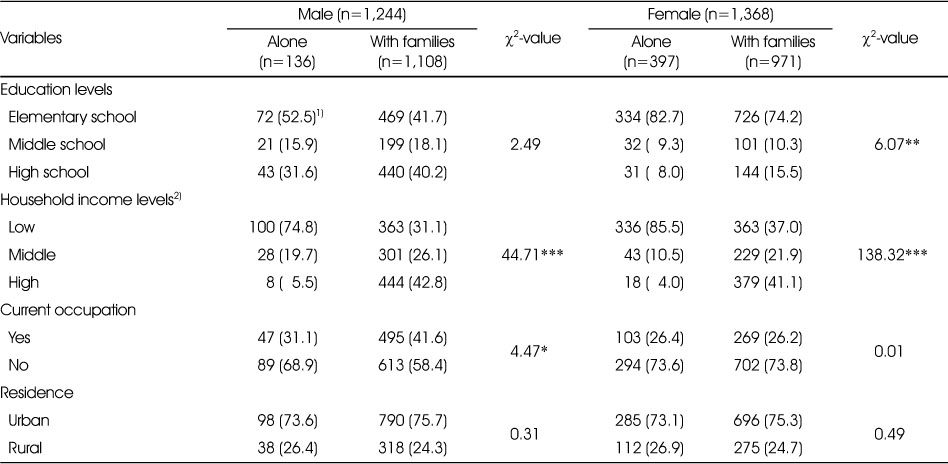
Daily energy and nutrient intakes of the elderly living alone and the elderly living with their families
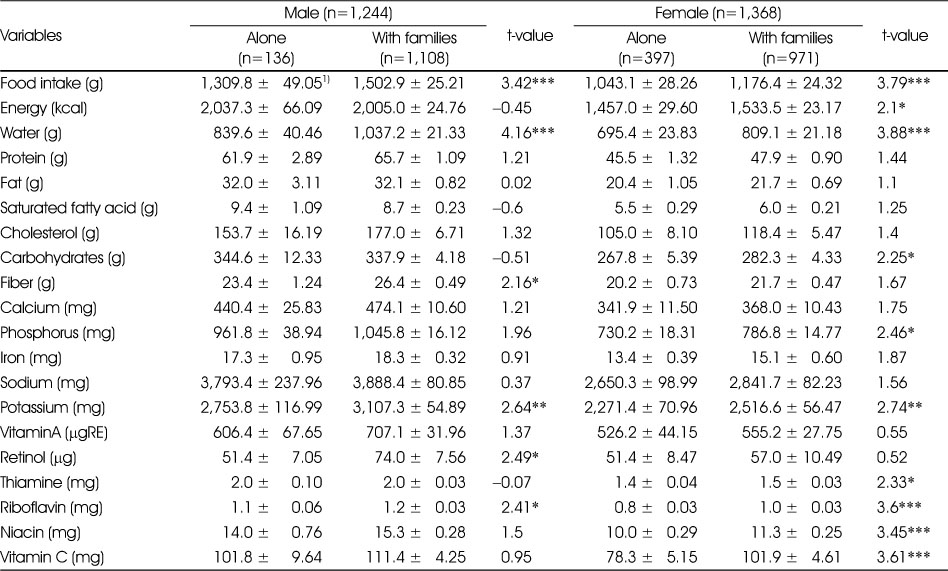
Energy nutrients and CPF ratio of the elderly living alone and the elderly living with their families
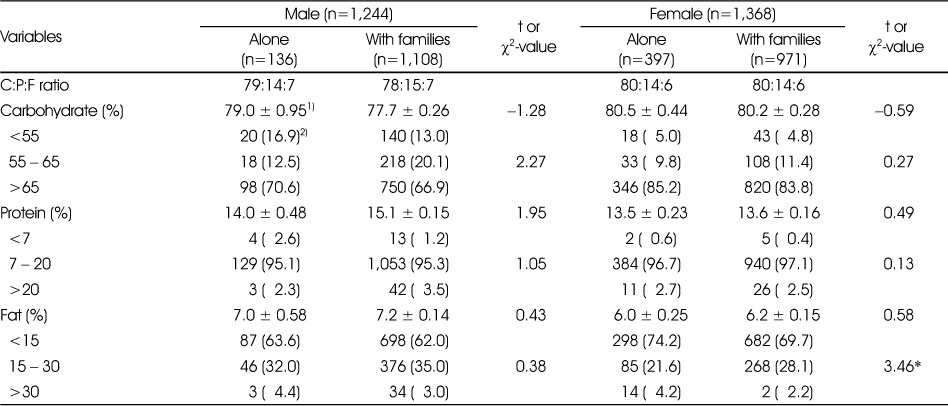
Estimated average requirement (EAR) of the elderly living alone and the elderly living with their families
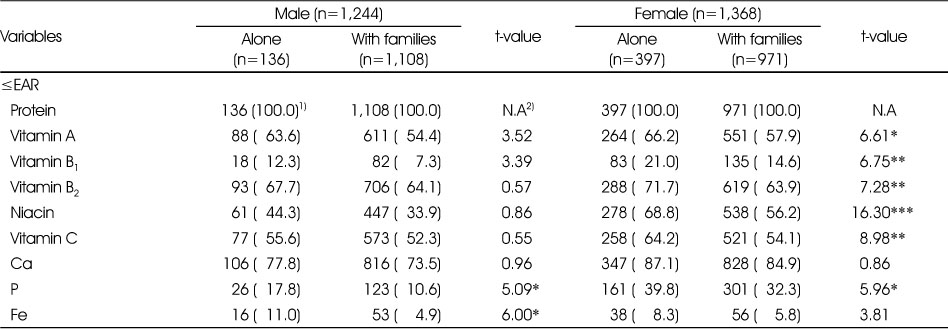
Nutrient adequacy ratio(NAR) and mean adequacy ratio(MAR) of the elderly living alone and the elderly living with their families
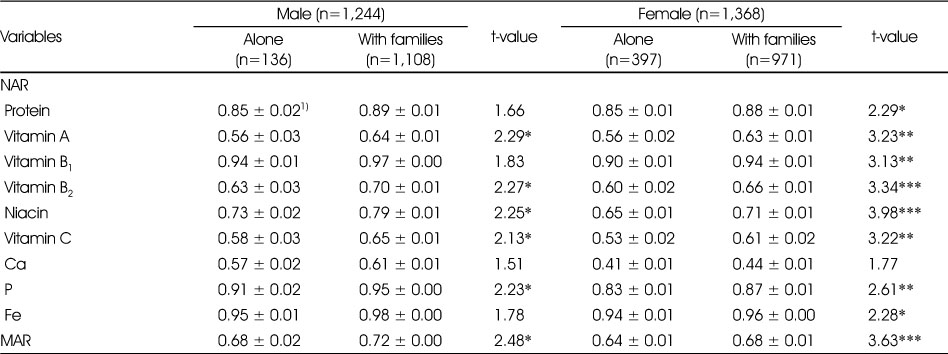
Index of nutrient quality (INQ) of the elderly living alone and the elderly living with their families
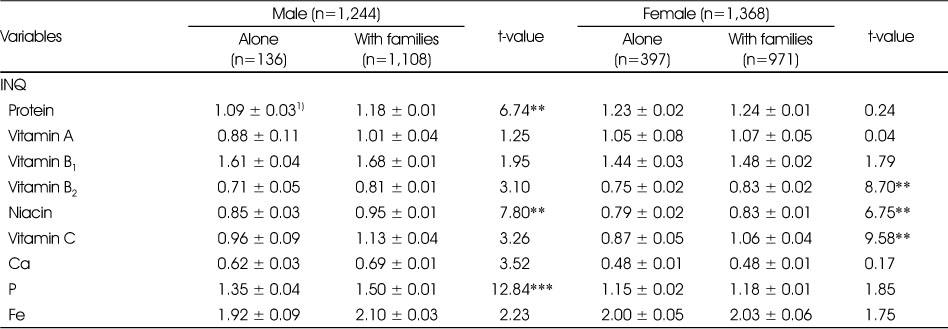
Figure & Data
REFERENCES
Citations

- Profiling the socioeconomic characteristics, dietary intake, and health status of Korean older adults for nutrition plan customization: a comparison of principal component, factor, and cluster analyses
Kyungsook Woo, Kirang Kim
Epidemiology and Health.2024; : e2024043. CrossRef - Evaluation on the Nutrition Quotient Scores of Elderly People Living Alone in Korea
Gyoungok Gang, Min Lee, Eun-hui Choi, Hye-Lim Lee, Hyun-Young Lee, Hye-Ja Chang, Jung-Hwa Choi, Na-Young Yi, Kyung-Eun Lee, Min-Jae Chung, Tong-Kyung Kwak
Nutrients.2023; 15(17): 3750. CrossRef - Changes in nutritional status of Korean older adults during COVID-19 Pandemic by household income and demographic factors-using the Korea National Health and Nutrition Examination Survey(2019-2020): a cross-sectional study
You-Sin Lee, Yoonna Lee
Korean Journal of Community Nutrition.2023; 28(4): 302. CrossRef - Comparison of the Nutrient Intake and Health Status of Elderly Koreans According to their BMI Status: Focus on the Underweight Elderly Population
You-Sin Lee, Yoonna Lee
Korean Journal of Community Nutrition.2022; 27(5): 422. CrossRef - Comparison of the health and nutritional status of Korean elderly considering the household income level, using the 2018 Korea National Health and Nutrition Examination Survey
Jin Mo Khil
Journal of Nutrition and Health.2021; 54(1): 39. CrossRef - Social participation, health‐related behavior, and depression of older adults living alone in Korea
Seojin Won, Hyemee Kim
Asian Social Work and Policy Review.2020; 14(1): 61. CrossRef - Evaluation of the dietary quality and nutritional status of elderly people using the Nutrition Quotient for Elderly (NQ-E) in Seoul
Sun-Wook Ham, Kyung-Hee Kim
Journal of Nutrition and Health.2020; 53(1): 68. CrossRef - Health and Nutrition Status of Elderly People with Multimorbidity: A Korea National Health and Nutrition Examination Survey (2013~2015)
Na-Gyeong Oh, Jung-Sook Seo
Korean Journal of Community Nutrition.2020; 25(6): 502. CrossRef
- We recommend
- Related articles
-
- Comparative study on the health and dietary habits of Korean male and female adults before and after the coronavirus disease 2019 pandemic: utilizing data from the 8 th Korea National Health and Nutrition Examination Survey (2019–2021)
- A comparison of serum lipid concentration by drinking habits based on the 7th Korea National Health and Nutrition Examination Survey (KNHANES VII) : a cross-sectional study
- Trends in Dietary Protein Intake and Its Adequacy among Korean Adults: Data from the 2010 ~ 2019 Korea National Health and Nutrition Examination Survey (KNHANES)
- Assessment of Nutrient Intake and Dietary Quality of Korean Adults in Metabolic Syndrome Patients According to Taking Medical Care: Based on the 2017 Korea National Health and Nutrition Examination Survey
- The Relationship Between the Korean Adults Diet Evaluated Using Dietary Quality Indices and Metabolic Risk Factors: Based on the 2016 ~ 2019 Korea National Health and Nutrition Examination Survey
General characteristics of the elderly living alone and the elderly living with their families
1) n (%)
2) Household income levels: ‘Low’=less than 100, ‘Middle’=101~200, ‘High’=exceed 200
*: p<0.05, **: p<0.01, ***: p<0.001
Dietary habits of the elderly living alone and the elderly living with their families
1) n (%)
2) Exclude: not applicable (meal frequency less than two times a week)
*: p<0.05, **: p<0.01, ***: p<0.001
Daily energy and nutrient intakes of the elderly living alone and the elderly living with their families
1) Mean ± S.E.
*: p<0.05, **: p<0.01, ***: p<0.001
Daily energy and nutrient intakes per 1,000 Kcal by households type
1) Model I: adjusted nutrient intake per 1,000 kcal
2) Mean ± S.E.
*: p<0.05
Energy nutrients and CPF ratio of the elderly living alone and the elderly living with their families
1) Mean ± S.E.
2) n (%)
*: p<0.05
Estimated average requirement (EAR) of the elderly living alone and the elderly living with their families
1) n (%)
2) not applicable
*: p<0.05, **: p<0.01, ***: p<0.001
Nutrient adequacy ratio(NAR) and mean adequacy ratio(MAR) of the elderly living alone and the elderly living with their families
1) Mean ± S.E.
*: p<0.05, **: p<0.01, ***: p<0.001
Index of nutrient quality (INQ) of the elderly living alone and the elderly living with their families
1) Mean ± S.E.
**: p<0.01, ***: p<0.001
Food consumption estimated by 24-hour recall of the elderly living alone and the elderly living with their families
1) Mean ± S.E.
*: p<0.05, **: p<0.01, ***: p<0.001
Food consumption estimated by 24-hour recall per 1,000 Kcal by households type
1) adjusted food consumption per 1,000 kcal
2) Mean ± S.E.
*: p<0.05, **: p<0.01, ***: p<0.001
1) n (%) 2) Household income levels: ‘Low’=less than 100, ‘Middle’=101~200, ‘High’=exceed 200 *: p<0.05, **: p<0.01, ***: p<0.001
1) n (%) 2) Exclude: not applicable (meal frequency less than two times a week) *: p<0.05, **: p<0.01, ***: p<0.001
1) Mean ± S.E. *: p<0.05, **: p<0.01, ***: p<0.001
1) Model I: adjusted nutrient intake per 1,000 kcal 2) Mean ± S.E. *: p<0.05
1) Mean ± S.E. 2) n (%) *: p<0.05
1) n (%) 2) not applicable *: p<0.05, **: p<0.01, ***: p<0.001
1) Mean ± S.E. *: p<0.05, **: p<0.01, ***: p<0.001
1) Mean ± S.E. **: p<0.01, ***: p<0.001
1) Mean ± S.E. *: p<0.05, **: p<0.01, ***: p<0.001
1) adjusted food consumption per 1,000 kcal 2) Mean ± S.E. *: p<0.05, **: p<0.01, ***: p<0.001

 KSCN
KSCN
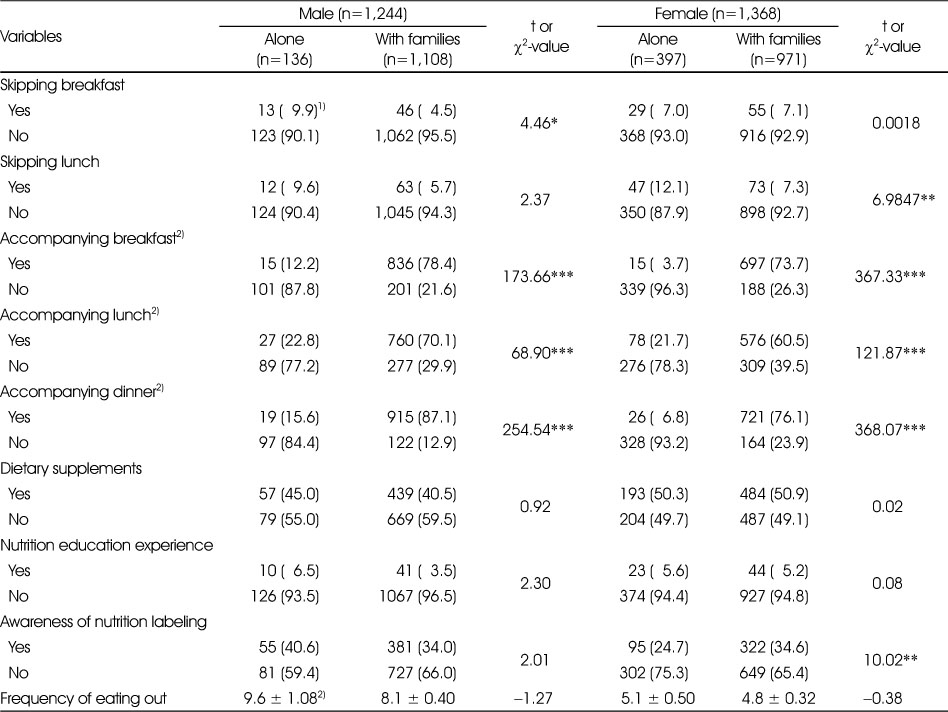
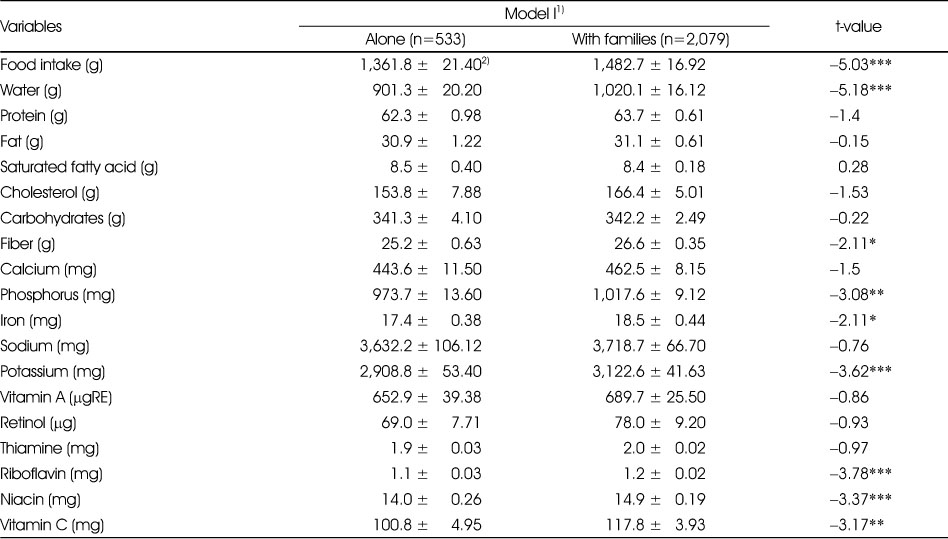
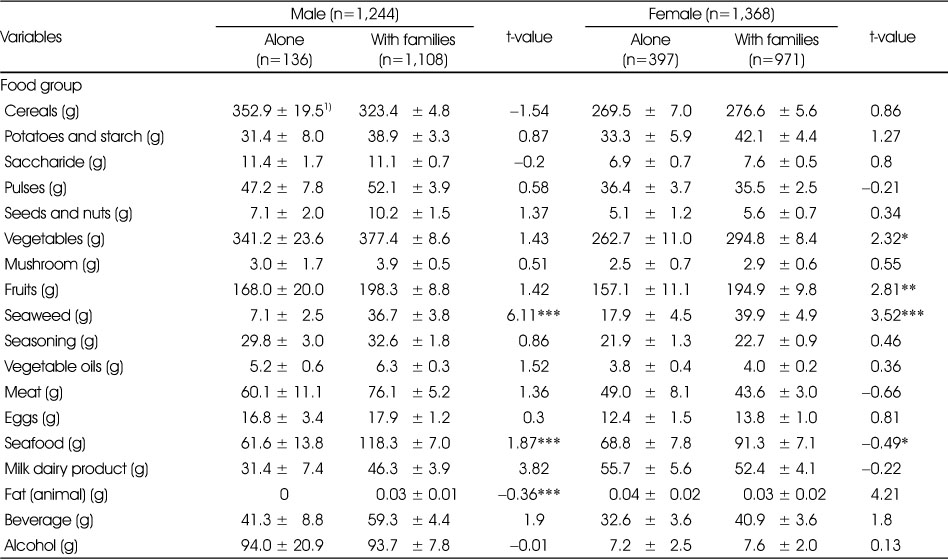
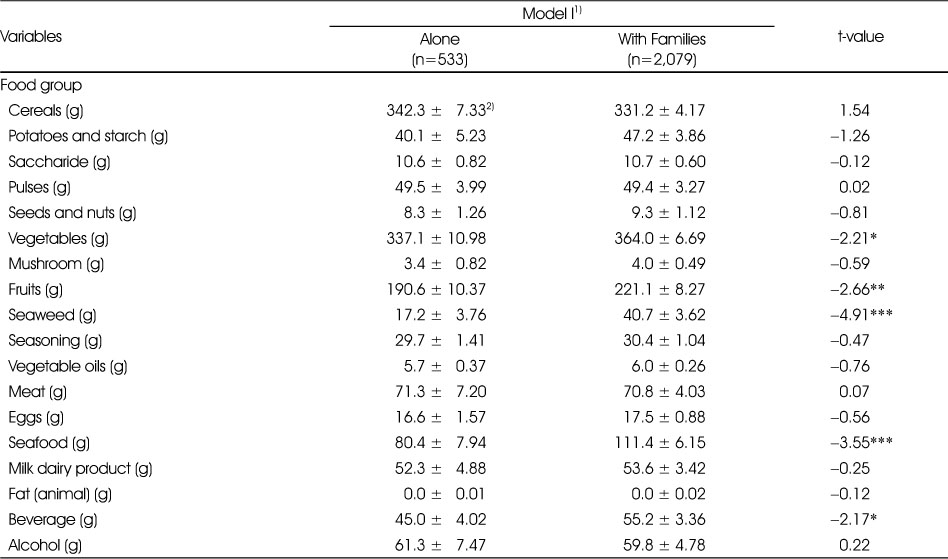
 PubReader
PubReader Cite
Cite


